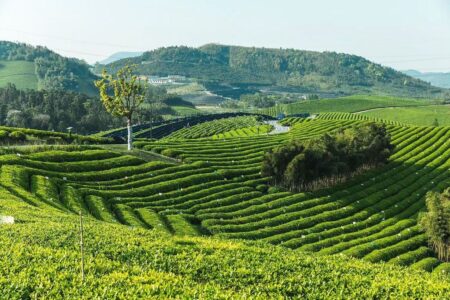Dissecting tea – one gene at a time

Research is being conducted to identify which genes within the tea genome help produce a quality crop. The results of this sequencing can be used to help develop cultivars that are resistant to critical stressors, thereby increasing the overall productivity of the plant.
By Anne-Marie Hardie
To say that the tea story is a complicated one is an understatement. Until recently, very little has been known about the genetic makeup of the two main varieties of tea: Camellia sinensis var sinensis and Camellia sinensis var assamica. Cultivars that were created were selected to hopefully duplicate a desirable trait. However, the specific location of the trait, and how the trait impacted the overall genome of the plant, was unknown.
An increase in the abiotic and biotic stressors impacting the tea plant has made it extremely important to identify the genes that can increase this plant’s resilience. Abiotic stressors, such as drought, extreme temperatures, high metal levels, and flooding, can harm the plant’s overall health and productivity levels. According to a review posted in Agricultural Science, Dr Sanjib Kumar Panda and Dr Hrishikesh Upadhyaya shared that when multiple abiotic stressors occur at the same time, it may interfere with nutrient absorption. There are also biotic stressors, insects and disease, which tea plants need to be able to resist. “Insects have been one of the critical challenges with tea,” said Dr Edwin Raj, assistant plant physiologist at Upasi Tea Research Institute, India. “The hope is that with tea genome research, we will be able to identify critical markers that help the plants adapt to these stressors.”
Understanding the Tea Code
The tea genome was initially sequenced in 2017 when a team of scientists, led by researcher Dr Xiaochun Wan of Anhui Agricultural University in Hefei, China was able to sequence the genome of a cultivar of Camellia sinensis var sinensis.
Around the same time, Dr Lizhi Gao, plant geneticist at the Kunming Institute of Botany, China, sequenced the genome of Yunkang 10, a cultivar of Camellia sinensis var assamica. Dr Gao reported that over the years, the research team had sequenced several plant genomes, but the tea genome was one of the most challenging to sequence. Part of this is because the genome itself was larger than initially anticipated, at approximately 3.02 billion base pairs in length.
In addition, several of the genes within the sequence are duplicates, or near duplicates. But that is not the only conundrum that has plagued scientists. Further exploration of the tea genome revealed what Dr Gao and colleagues called “jumping genes.” These genes are sequences within the genome where the genes have essentially copied themselves in a variety of locations. These duplications, which make up approximately 67 percent of the genome sequence, is part of the reason why the actual size of the genome is so extensive. But this is not the only interesting fact. Some of the genes that the plant naturally duplicated included some disease resistant ones. It appeared that the plant, over time, recognized the genes that helped with adaptation and began to reproduce these genes on its own.
Jumping Genes
Gao’s research team believes that these jumping genes, some of which may have been the result of cultivation, may have helped the plant adapt to climate change, and other environmental stressors. In addition, they may also explain how the tea plant seems to cope well across several continents and in variable climate conditions.
The Upasi Tea Research Institute in India has also identified the value of genome mapping the camellia sinensis cultivars. Currently, the researchers are embarking on one of the largest genome sequencing projects. “We are looking at several aspects of the plant’s genome including the metabolic aspects to help determine the features that can help the plant adapt to abiotic and biotic stressors,” said Raj. The potential benefits from this research are extensive including being able to outline key gene markers which could then be used in plant breeding programs.
“Knowing the genes will help with micro breeding,” said Dr S Ashokraj, biotechnologist, Upasi Tea Research Institute. “We are hoping to identify certain markers that help the plant adapt to adverse situations.” The research team is looking at current challenges including climate change, foreign pathogens, and insects. The hope is that by identifying the genes that aid in resistance, researchers can then use this information to cross breed desirable traits.
In Japan, Dr Fumiya Taniguchi and his research team at the Institute of Fruit Tree and Tea Science, Makurazaki, Japan, have already embarked on this type of study.
To date, approximately 75 percent of the plants in Japanese tea fields are from the cultivar Yabukita. The challenge with this cultivar is that it is susceptible to several insects and diseases and does not adapt well in all of Japan’s climates. The tea researchers recognized the need to identify and breed a new resistant cultivar. Their goal was to develop a cultivar that was naturally resistant to the sap-sucking insect (white peach scale). Taniguchi and his team used DNA marker assisted selection to develop a resistant new cultivar, which they called Nanmei.
Additional cross-breeding programs have led to the development of Benifuki, a cultivar that is used to produce a semi-fermented tea. The Japanese researchers were actively seeking a variety that would appeal to the European and North American palate. Benifuki responds to this need by offering the market a flowery flavoured green tea.
New Research Reveals a Potential Alternative to Decaffeinated Tea
Caffeine is another challenge that the tea industry has had to contend with. Consumers seeking to limit the amount of caffeine in their diet have two options: tisanes (caffeine-free herbals or rooibos) or decaffeinated teas. The decaffeination process is far from ideal as it can alter the flavour profile of the tea.
The production of caffeine is mainly due to a plant’s defense mechanism; therefore, several plants including coffee and cacao have caffeine. The caffeine enzyme, which in tea is called caffeine synthase, is produced as a defense mechanism thereby increasing the plant’s overall resistance to insects. In fact, in some cases the enzyme can either disable or even kill some insects.
This past November, the Journal of Agricultural and Food Chemistry shared the discovery of Hongyacha, a naturally occurring caffeine-free tea plant from the Fujian region in China. Having a plant with naturally low levels of caffeine will help ensure that the leaves retain the positive aspects of the tea plant without the added caffeine. The research team headed by Dr Liang Chen used high-performance liquid chromatography on the buds and leaves that were picked during growing season. This method revealed not only several health-promoting compounds, but it also confirmed that the wild cultivar contained very little caffeine. Further analysis by the team revealed that the low caffeine levels were a result of a gene mutation, in the enzyme tea caffeine synthase, which is responsible for producing caffeine in most tea plants.
The tea genome story is far from finished. “We need to be able to identify which genes within the tea genome help produce a quality crop,” said Ashokraj. “The long-term goal is to use this information to obtain plants that are higher quality and able to resist climate change.” The results of this sequencing can be used to help develop cultivars that are resistant to critical stressors, increasing the overall productivity of the plant. At the same time, the information can be used to develop varieties that will respond to the ever-changing needs of the consumer.
Anne-Marie Hardie is a freelance writer, professor and speaker based in Barrie, Ontario. She may be reached at: [email protected].



